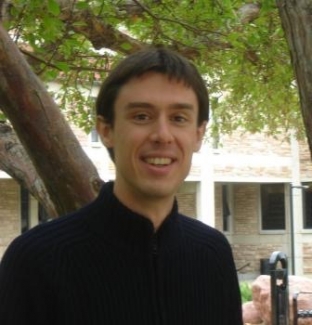Quéméner
Nickname: Gugu
Specialization: Ultracold molecular collisions.
PhD: IPR, University of Rennes, 2006.
With group: 2008-2012.
Current Whereabouts: Laboratoire Aimé Cotton, Paris
Quotes:
"Convince me that the short-range is not important."
"Good Wronskians always lead to good results."
"Oh, I can handle divergences."
"Time to cut the ham!"
Web: http://grizzly.colorado.edu/~goulven/
Caught in the act: here Goulven studies molecular physics.
Quéméner publications in the group
Controlling the Hyperfine State of Ro-vibronic Ground State Polar Molecules -- S. Ospelkaus, K.-K Ni, G. Quéméner, B. Neyenhuis, D. Wang, M. H. G. de Miranda, J. L. Bohn, J. Ye, and D. S. Jin, Phys. Rev. Lett. 104, 030402(2010).
Strong Dependence of Ultracold Chemical Rates on Electric Dipole Moments -- G. Quéméner and J. L. Bohn, Phys. Rev. A 81, 022702 (2010).
Quantum-State Controlled Chemical Reactions of Ultracold Potassium-Rubidium Molecules-- S. Ospelkaus, K.-K. Ni, D. Wang, M. H. G. de Miranda, B. Neyenhuis, G. Quéméner, P. S. Julienne, J. L. Bohn, D. S. Jin, and J. Ye, Science 327, 853 (2010).
Dipolar Collisions of Polar Molecule in the Quantum Regime -- K.-K. Ni, S. Ospelkaus, D. Wang, G. Quéméner, B. Neyenhuis, M. H. G. de Miranda, J. L. Bohn, J. Ye, and D. S. Jin, Nature 464, 1324 (2010).
Electric-Field Suppression of Ultracold Confined Chemical Rates -- G. Quéméner and J. L. Bohn, Phys. Rev. A 81, 060701(R) (2010).
A Simple Quantum Model of Ultracold Polar Molecule Collisions -- Z. Idziaszek, G. Quéméner, J. L. Bohn, and P. S. Julienne, Phys. Rev. A 82, 020703(R) (2010).
Dynamics of Ultracold Molecules in Confined Geometry and Eelctric Field -- G. Quéméner and J. L. Bohn, Phys. Rev. A 83, 012705 (2011).
Controlling the Quantum Stereodynamics of Ultracold Bimolecular Chemical Reactions -- M. H. G. de Miranda, A. Chotia, B. Neyenhuis, D. Wang, G. Quéméner, S. Ospelkaus, J. L. Bohn, J. Ye, and D. S. Jin, Nature Physics 7, 502 (2011).
Universalities in Ultracold Reactions of Alkali-Metal Polar Molecules -- G. Quéméner, J. L. Bohn, A. Petrov, and S. Kotochigova, Phys. Rev. A 84, 062703 (2011).
Evaporative Cooling of the Dipolar Radical OH -- B. K. Stuhl, M. T. Hummon, M. Yeo, G. Quéméner, J. L. Bohn, and J. Ye, Nature 492, 396 (2012).
Scattering of Ultracold Molecules in the Highly Resonant Regime -- M. Mayle, G. Quéméner, B. P. Ruzic, and J. L. Bohn, Phys. Rev. A 87, 012709 (2013).
Dipolar Radicals in Crossed Electric and Magnetic Fields -- J. L. Bohn and Quéméner, Mol. Phys. 111, 1931 (2013).
Ultracold Molecular Collisions in Combined Electric and Magnetic Fields
G. Quéméner and J. L. Bohn, Phys. Rev. A 88, 012706 (2013).
Shielding 2S Ultracold Dipolar Molecular Collisions with Electric Fields
G. Quéméner and J. L. Bohn, Phys. Rev. A 93, 012704 (2015).
Adimensional theory of shielding in ultracold collisions of dipolar rotors
Maykel L. Gonzalez-Martinez, J. L. Bohn, and G. Quéméner, Phys. Rev. A 96, 032718 (2017).
A Unified Model of Ultracold Molecular Collisions
J. F. E. Croft, J. L. Bohn, and G. Quéméner, Phys. Rev. A 102, 033306 (2020).
Other Quéméner publications at JILA
Inelastic collisions and density-dependent excitation suppression in a (87)Sr optical lattice clock -- Phys. Rev. A 84, 052716 (2011).
Cold-collision-shift cancellation and inelastic scattering in a Yb optical lattice clock -- Phys. Rev. A 84, 052724 (2011).
Ultracold Molecules Under Control! -- Chem. Rev. 112, 4949 (2012).

Laboratoire Aimé Cotton, Paris


 The Physics Frontiers Centers (PFC) program supports university-based centers and institutes where the collective efforts of a larger group of individuals can enable transformational advances in the most promising research areas. The program is designed to foster major breakthroughs at the intellectual frontiers of physics by providing needed resources such as combinations of talents, skills, disciplines, and/or specialized infrastructure, not usually available to individual investigators or small groups, in an environment in which the collective efforts of the larger group can be shown to be seminal to promoting significant progress in the science and the education of students. PFCs also include creative, substantive activities aimed at enhancing education, broadening participation of traditionally underrepresented groups, and outreach to the scientific community and general public.
The Physics Frontiers Centers (PFC) program supports university-based centers and institutes where the collective efforts of a larger group of individuals can enable transformational advances in the most promising research areas. The program is designed to foster major breakthroughs at the intellectual frontiers of physics by providing needed resources such as combinations of talents, skills, disciplines, and/or specialized infrastructure, not usually available to individual investigators or small groups, in an environment in which the collective efforts of the larger group can be shown to be seminal to promoting significant progress in the science and the education of students. PFCs also include creative, substantive activities aimed at enhancing education, broadening participation of traditionally underrepresented groups, and outreach to the scientific community and general public.